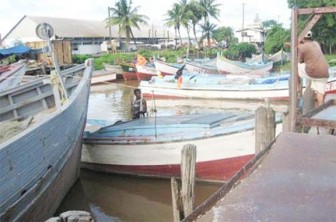With Guyana’s fisheries under threat from overfishing, pollution, destructive fishing practices and climate change, the implementation of an Ecosystem Approach to Fisheries (EAF) is being advocated to ensure sustainable management of the resources.
This was emphasised yesterday when the Ministry of Agriculture in partnership with the Food and Agriculture Organisation (FAO) hosted a National Consultation Work-shop on the EAF at the Regency Suites Hotel, to discuss the findings of a case study conducted for Guyana by the Caribbean Large Marine Ecosystem (CLME) Project.
The case study on shared stocks of the shrimp and ground-fish of the Guianas-Brazil Shelf is a CLME initiative funded by the Global Environment Fund at a cost of US$253,000. The 16-month study, which spans Brazil, French Guiana, Guyana, Suriname, Trinidad and Tobago and Venezuela and will run until November, was developed in response to the serious challenges confronting the marine ecosystems of the Caribbean.

As part of the study, national consultations were convened with stakeholders involved in the fisheries industry to ascertain issues affecting fisheries and possible solutions. The recommendations that will come from the workshop and others in the other participating countries will be used to develop a Strategic Action Plan. This will be the basis for countries like Guyana to obtain resources for the implementation of recommendations coming from the study.
To emphasise the scope of the problem, FAO Represen-tative for Guyana Dr Lystra Fletcher-Paul said that Guyana’s fisheries are under threat and revealed that up to a few years ago the country used to be one of the region’s largest exporters of shrimp and prawns. “Today, one would be lucky to find local shrimps in the supermarkets. The stocks have been depleted because of overfishing, use of destructive fishing practices and open access of many fisheries,” she said.
Also making a case for the project, Programme Manager for the Caribbean Regional Fisheries Mechanism (CRFM) Terrence Phillips noted that all the penaeid shrimp species in the region are subjected to increasing trends in fishing mortality and that the fisheries are generally over-capitalised. With regard to fisheries of Guyana-Suriname, he reported that ground-fish, despite relatively stable catches, overexploitation was found to be severe for some species, and that there is evidence that some of the fisheries in this area may be fully or overexploited.
According to a Draft EAF Baseline Report on Guyana, dumping of trash, habitat damage by sledges, the use of pin seines, Chinese seines and gillnets used near the shore, drift seines pollution from offshore vessels, coastal and inland pollution and even natural cycles of erosion and accretion are but a few of the many factors that impact our fish stocks. It also stated that external factors such as effluents from land-based activities containing pollutants, siltation resulting from indiscriminate deforestation and coastal development which results in habitat modification and degradation have had inverse effects on the fish resources found in Guyana.

Fletcher-Paul also blamed climate change for potential negative implications to the industry since it is likely to affect it “in ways that are difficult to predict.”
According to both presenters, there are obvious reasons why this approach to fishing cannot be allowed to persist, including the fact that fish contribute a significant amount of animal protein to the diet of people worldwide and the industry being a source of livelihood for approximately 55 million men and women around the world, 95% of whom reside in developing countries such as Guyana.
The Draft EAF Baseline Report on Guyana revealed that in 2005 approximately 10,500 people made their living from the industry, albeit in varying areas ranging from actual fishermen to vendors. It also showed that in 2010, Guyana exported $9.01 billion in fish, and that in 2011 exports in fish made up 13.36% of its Gross Domestic Product.
In this context, Fletcher-Paul said it is absolutely imperative that decision makers act now and decisively to make the fisheries sub-sectors less vulnerable to both the internal and external threats and thereby ensuring the sustainability of the resource.

The overall objective of the project, according to her, is to improve management practices through the implementation of the EAF at national and sub-regional levels, thereby ensuring that maximum benefits can be gained from the resources and improving the livelihoods of those directly and indirectly dependent on fisheries.
Phillips reinforced this point, stating that it is important that we exploit these resources to address the needs and desires of our society without depriving future generations of the benefits of our marine ecosystems.
As a result, the EAF approach is being touted internationally as an effective, comprehensive and systematic way of addressing the most pressing sustainability issues of the fisheries sectors. It recognises the main internal and external factors affecting sustainability, allowing for the development of clear plans to address the main issues.
“It allocates responsibilities for action, it identifies incentives for compliance and, perhaps most importantly, empowers stakeholders to take a hands on approach to the decision-making process which gives them greater ownership and responsibility for the management of their county’s fisheries resources,” Fletcher-Paul added.
She said a significant portion of the responsibility for the successful implementation of this project hinges squarely on the shoulders of the government, which has a responsibility to create an enabling environment for the formulation and enforcement of the policies and legislation necessary to promote sustainable fisheries management.
The FAO, Fletcher-Paul further said, has been providing support to Guyana’s fisheries sector for over 20 years in areas such as institutional strengthening, capacity building, fish stock assessment and aquaculture. A few months ago the hosting of a national stakeholder consultation led to the preparation of a draft policy for inland fisheries, which is currently being reviewed, she noted. The second consultation will be held next week where the final policy and strategic plan will be agreed upon. She said a disaster risk management plan for the fisheries sector of the agriculture sector is also being created and the draft of this policy will be presented later this month.
Present at the opening ceremony of the workshop yesterday were various stakeholders in Guyana’s fisheries industry, including members of the Fisheries Department as well as industrial and small-scale fishers and their organisations. Also addressing the gathering were Dr Leslie Ramsammy, Minister of Agriculture and Denzil Roberts, and Chief Fisheries Officer of the Ministry of Agriculture.




